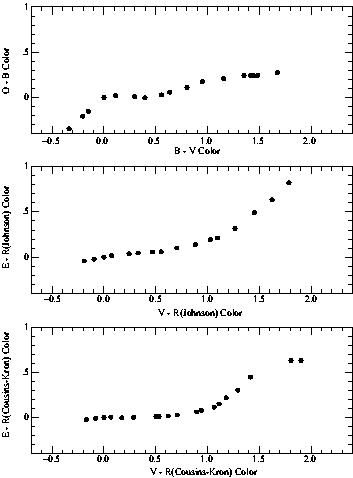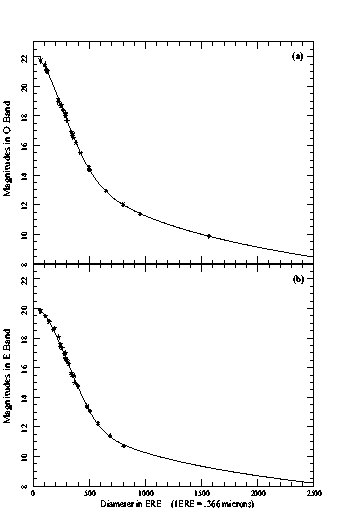Photometry
The photometric calibration for stars uses a magnitude-diameter relation derived from photoelectric BV, BVRJ and CCD BVRc calibrating sequences. Our CCD sequences were obtained at Capilla Peak Observatory (University of New Mexico), Cerro Tololo Interamerican Observatory and McDonald Observatory, and our photoelectric photometry at Kitt Peak National Observatory (Humphreys et al. 1991) . The sequences range from about 13 to 20-21 mag. and are transformed to the instrumental (emulsion + filter system) O and E magnitudes corresponding to the blue and red Sky Survey plates, respectively (Humphreys et al. 1991). The color transforms are shown in Figure 1. We supplement our photometry with data for brighter stars from the Guide Star Photometry Catalog (Lasker et al. 1988) to give a calibration from ∼10 to 20-21 mag for the O plates. The calibrating sequences are included in the archived database.
The diameters are measured from the best-fit ellipse to the single level of isodensity data. The magnitude-diameter relations for each field are then fit by a smooth curve whose expected shape is derived from the stellar PSF (King 1971; Kormendy 1973). The resulting fits typically have a mean rms of 0.15-0.20 mag over the range 14-20 mag. Sample magnitude-diameter relations are shown in Figure 2. The APS magnitudes are most reliable fainter than 12th mag because of the diffraction pattern, and are not available for objects brighter than 8th magnitude.
Humphreys et al. (1991) found that the magnitude-diameter relations for the POSS I fields all have essentially the same form or shape with small zero-point variations. Thus for those fields for which we do not have CCD or photoelectric calibration to the fainter magnitudes, we use the mean relation fit to the brighter stars in the GSPC (BV photometry only). We obtain the necessary R photometry with the CCD camera at the Univ. of Minnesota's O'Brien Observatory or assume that the GSPC stars are main sequence stars and adopt the corresponding V-Rc color. Tests of this method on well-calibrated fields give magnitudes agreeing to within 0.2 mag.
Schmidt plates have a systematic vignetting error across the field. The vignetting correction is a function of the radial distance from the plate center with no correction out to ≈ 2.7°. We have tested the expected or theoretical vignetting function by a comparison with a grid of CCD frames on two POSS fields, critically placed in the plate corners and along the radial, horizontal and vertical axes. Our empirically-determined correction (maximum ∼0.3 mag in the plate corners) is consistent with the expected function. The vignetting function is included in the reductions and the corrections are applied to the measured magnitudes where appropriate.
Because galaxy images are extended on the sky, a more elaborate method of photometry than that used in stellar photometry is required. We have developed a set of plate calibration techniques to derive the density-to-intensity transformation properties of each glass copy plate and to set the photometric zero-point based on available stellar photometry. The most fundamental method uses a direct link between APS galaxy luminosity profiles and available high-quality photometric profiles derived from CCD images to establish a simple linear transformation in log(I)-D space, where D is the raw photographic density as measured by the APS. In the absence of available surface photometry, which is the case for most POSS I fields, we adopt a density-to-intensity transformation derived by comparing the mean stellar point spread functions of stars over a wide range in magnitude (Bunclark & Irwin 1984). The profile slope is derived from the bright stars and the zero point is set by the photometric standards. We use the background subtracted pixel data for both the stars and galaxies to derive the integrated magnitude. Due to the small plate scale of the POSS I and the adverse effects of scattered light in the presence of saturated stellar cores, this method is not as effective as the previous one, but it does produce sufficiently reliable results. In addition the stellar PSF technique produces an estimate of the seeing on each plate.
Comparing our O and E band radial surface brightness profiles with three independent sources of galaxy surface photometry, we found no systematic deviation in surface brightness over the ranges 21.0 ≤ μO ≤ 24.5 and 20.5 ≤ μE ≤ 23.5. The accidental errors associated with the APS surface brightness measurements are in the range 0.07 ≤ σμ ≤ 0.15 for both the O and E plates. Comparison with available photometry in the RC3 and fainter galaxy catalogs at the NGP show that APS-derived integrated galaxy magnitudes (extrapolated total magnitudes in the case of O ≤ 17) show no systematic photometric errors for O ≤ 19.5 and a typical rms scatter of 0.2 to 0.3 magnitudes (see Odewahn & Aldering (1995)).
The integrated (magi) and the magnitude-diameter relation (magd) magnitudes are both included in the Catalog for every object. Obviously, magd should be used for stars and magi for galaxies. The advantage of including both for each object occurs if a "star" is later found to be a "galaxy" or vice-versa, then the appropriate magnitude is available.


